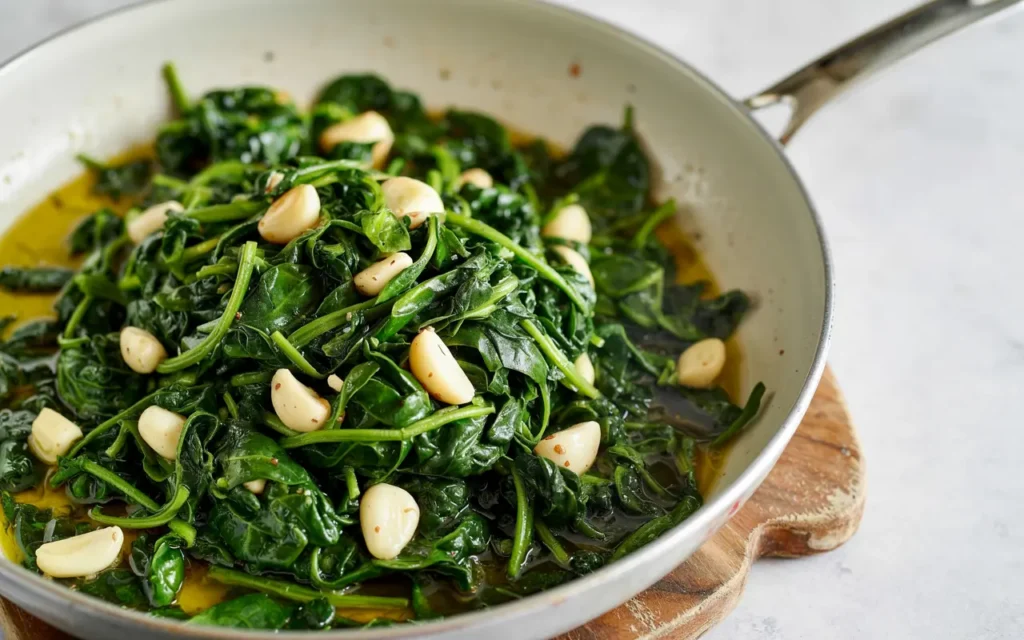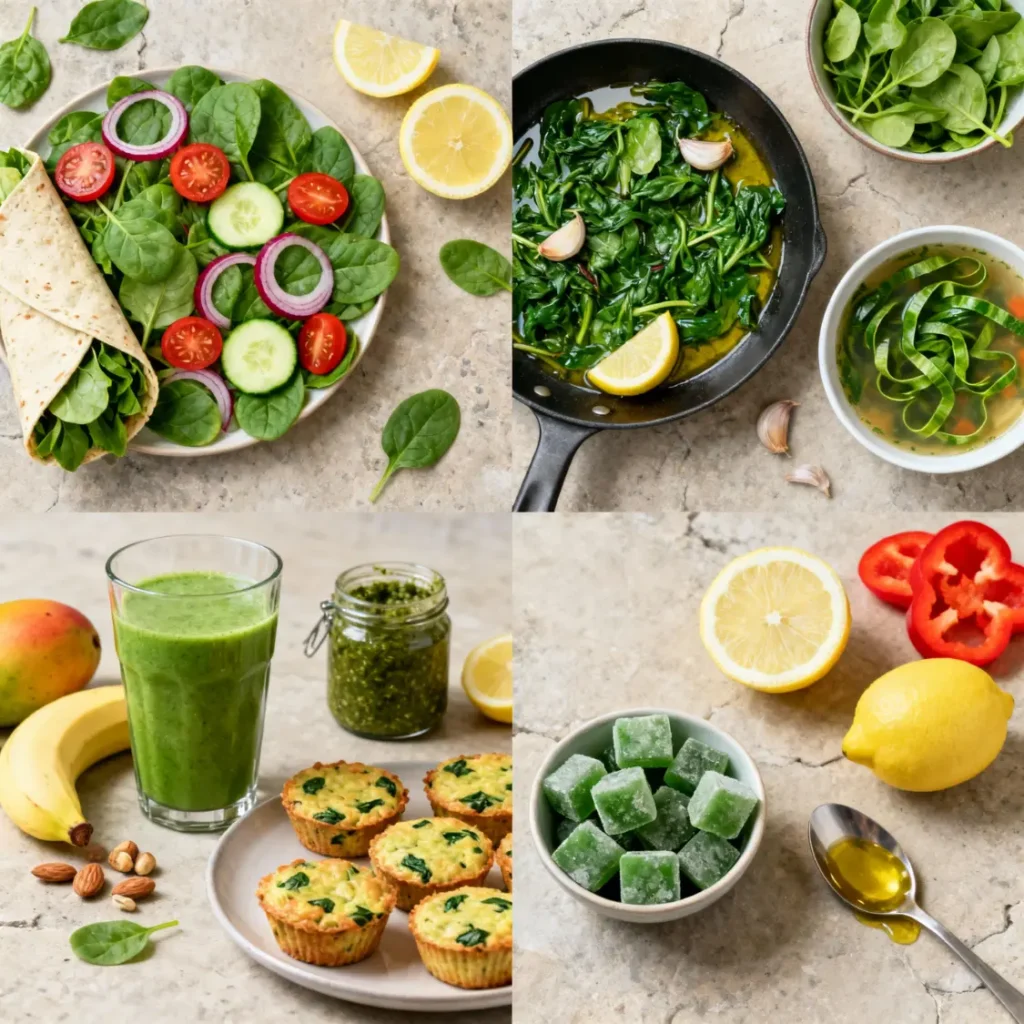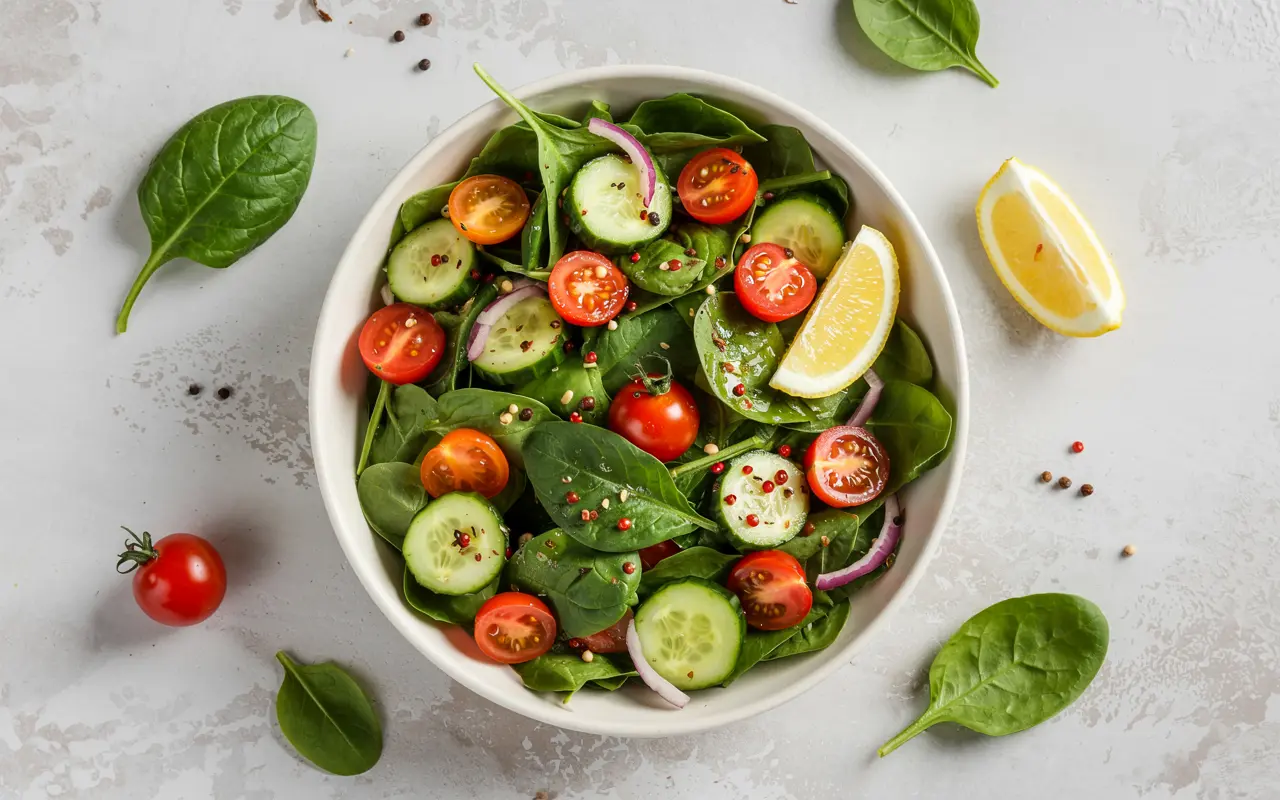From breakfast smoothies to quick dinners, spinach works hard for you. More nutrients, fewer calories, easy wins every day.
Table of Contents
Spinach is an easy upgrade for busy eaters. It is nutrient dense, low in calories, and versatile in smoothies, skillets, soups, and quick lunches. Below you will find the most important Benefits of Spinach, how to use it without fuss, and answers to common questions, written for everyday cooks in the U.S.
Listen to the Podcast with Chef Brooke
Join Mia and Chef Brooke from ZurbanRecipe as they explore how spinach powers your energy, strengthens your bones, and keeps your heart happy. A quick, flavorful talk that makes you see this leafy green in a whole new way.
What’s Inside a Handful of Spinach?
Vitamins, Minerals, and Phytonutrients
A single cup of spinach packs nutrients that explain the real Benefits of Spinach you feel day to day. You’ll find:
- Vitamin K – bone strength and healthy clotting
- Vitamin A – clear vision and immune support
- Vitamin C – antioxidant defense and better iron absorption
- Folate (B9) – energy metabolism, DNA repair, red blood cells
- Iron, Magnesium, Calcium – muscle function, nerve balance, bone stability
Together, these nutrients form the foundation of Spinach Benefits like stronger bones, steadier energy, and protection from oxidative stress.
Antioxidants That Protect Your Eyes
Spinach is rich in lutein and zeaxanthin, two compounds that concentrate in the retina to defend against blue light and UV stress. They work like built-in sunglasses, supporting sharp vision and reducing age-related eye risks.
To make the most of the Benefits of Spinach, pay attention to how you cook it.
💡 Best method: Light steaming or sautéing retains most nutrients and improves absorption without sacrificing flavor.
Key Health Benefits of Spinach Explained
A nutrient dense leafy green, spinach delivers real results you can feel. The Benefits of Spinach include support for eyes, bones, immunity, heart health, and steady energy.
Supports Eye Health and Clear Vision
Spinach provides lutein and zeaxanthin that concentrate in the retina. They help filter blue light and reduce oxidative stress. Vitamin A further supports low light vision and keeps eyes moist and comfortable.
You’ll get powerful antioxidants like lutein and zeaxanthin from spinach, but don’t stop there. Pairing spinach with broccoli gives your eyes and immune system a broader nutrient base. Or enjoy the benefits in a real meal like this creamy garlic spinach chicken, where spinach blends into a warm, flavorful dish packed with comfort and nutrition.
Strengthens Bones and Aids Muscle Function
Vitamin K helps direct calcium to your bones. Magnesium and calcium assist normal muscle contraction and relaxation. Regular intake supports bone density and post workout recovery.
Immune Support and Inflammation Balance
Vitamins A and C plus antioxidants help your skin and mucosal barriers do their job. They neutralize free radicals and support a healthy inflammatory response for everyday resilience.
May Support Heart Health
Natural nitrates can promote better blood flow and help maintain healthy blood pressure. Fiber and antioxidants support healthy cholesterol balance and overall cardiovascular wellness.
Steady Energy and Iron Absorption
Spinach offers non heme iron and folate for red blood cells and energy metabolism. Pair with vitamin C foods like lemon or bell peppers to improve absorption. This simple habit amplifies Spinach Benefits without extra effort.
Quick How To Make It Work
- Add a handful to omelets, soups, or pasta sauces
- Lightly steam or quick sauté to keep nutrients
- Rotate raw and cooked through the week for a complete profile
Spinach proves that simple choices add up. Keep it in your weekly routine, and the Benefits of Spinach become part of your everyday strength and vitality.
Raw vs Cooked, What Changes
Spinach works both ways. Raw leaves keep crunch and vitamin C, while gentle heat shrinks volume and can improve mineral availability. To capture the Benefits of Spinach, use both across the week.
What Raw Spinach Gives You
- Crisp texture for salads and sandwiches
- Maximum vitamin C and folate retention
- Easy to blend into smoothies without altering flavor
What Lightly Cooked Spinach Improves
- Better access to minerals like iron and calcium
- Big volume reduction so you eat more greens per serving
- Softer texture for omelets, soups, and quick sides
Best Cooking Methods
- Light steaming, 1 to 2 minutes, just until wilted
- Quick sauté with olive oil and garlic, 2 to 3 minutes
- Add at the end of soups and stews so it only wilts

💡 Best method: Light steaming or a quick sauté retains most nutrients and improves absorption without sacrificing flavor.
Simple Tips That Boost Results
- Pair with vitamin C foods like lemon or bell pepper to improve iron absorption
- Do not overboil, long boiling reduces vitamin C and folate
- Fresh or frozen both work. Frozen is budget friendly and always ready
- Drain gently after cooking. Press out excess water to avoid watery dishes
Use this mix of raw and lightly cooked preparations and you lock in Spinach Benefits with zero effort.
How to Add Spinach Every Day
Make it a habit and the Benefits of Spinach stack up fast. Use these simple ideas you’ll actually keep.
Quick Raw Ideas You Will Actually Use
- Toss a handful into salads with tomatoes, cucumbers, and lemon
- Layer into sandwiches and wraps for extra crunch
- Blend into smoothies with banana, mango, or peanut butter
- Add to grain bowls for volume without extra calories
Cozy Cooked Ideas for Busy Nights
- Quick sauté with olive oil and garlic, finish with a squeeze of lemon
- Stir into soups, stews, or chili during the last few minutes
- Fold into omelets, scrambles, or frittatas
- Stir through warm pasta sauce right before serving
Blend, Bake, and Saucy Uses
- Spinach pesto with nuts, garlic, and lemon for a bright spread
- Creamy skillet sauce, wilt spinach into a light cream or yogurt base
- Savory muffins or crustless quiche for easy meal prep
Tiny Tweaks That Pay Off
- Keep a bag of frozen spinach for weeknights, no washing, no waste
- Pair with vitamin C foods (lemon, bell pepper) to help iron absorption
- Alternate raw and lightly cooked across the week for balanced Spinach Benefits

Small, repeatable choices are what count. Add a handful here and there, and you’ll feel the difference without changing your whole routine.
Tips To Keep The Good Stuff
Lock in the Benefits of Spinach with simple kitchen habits that fit busy weeks.
Choose and Store Smart
- Pick deep green leaves, avoid yellowing or slimy spots
- Store in a breathable bag with a paper towel, change it if damp
- Use within 3 to 5 days, or keep frozen spinach on hand for backups
Prep That Saves Nutrients
- Rinse quickly under cold water, dry well before cooking
- Chop just before use, long exposure to air reduces freshness
- Add salt near the end of cooking, early salting can weep water
Heat, Time, and Equipment
- Aim for light steaming, 1 to 2 minutes, or a quick sauté, 2 to 3 minutes
- Use a wide skillet so leaves wilt fast and evenly
- Cover briefly to trap steam, then uncover to let excess moisture escape
Pairings That Boost Absorption
- Add vitamin C, lemon, bell pepper, tomatoes, it helps non-heme iron uptake
- Include a little fat, olive oil, avocado, nuts, carotenoids absorb better
- Combine with calcium foods at meals if you are sensitive to oxalates
Zero-Waste Ideas
- Freeze small portions in ice cube trays for smoothies and sauces
- Stir leftover cooked spinach into eggs, grains, or soup the next day
- Blend stems into pesto or green sauces for extra fiber
These small choices keep flavor, texture, and nutrients, and make Spinach Benefits easy to capture meal after meal.
Myths and Facts About Spinach
Even the healthiest greens come with confusion. Here’s what’s true about the Benefits of Spinach and what’s just myth.
Is Spinach Bad for Kidney Stones
Spinach contains oxalates, natural compounds that can contribute to kidney stone formation for people already prone to calcium-oxalate stones. For most healthy adults, moderate amounts are perfectly safe.
While spinach contains oxalates, moderate consumption as part of a balanced diet is generally safe for most people. Pairing spinach with calcium-rich foods can reduce oxalate absorption. A review from the National Institutes of Health highlights how natural foods like spinach may also support cellular protection and disease prevention.
💡 Tip: Pair spinach with calcium-rich foods and drink plenty of water to help bind oxalates and reduce buildup. Moderation works better than avoidance.
Does Cooking Destroy Its Nutrients
Not exactly. While heat lowers some vitamin C and folate, it actually makes iron, calcium, and magnesium easier to absorb. Mixing raw and lightly cooked spinach through the week gives you balanced Spinach Benefits from both versions.
Can You Eat Spinach Every Day
Yes. Regular servings support steady vitamin and mineral intake without excess calories or oxalate concerns. Variety is key: smoothies, sautés, or soups all count. According to the Harvard T.H. Chan School of Public Health, regularly eating dark leafy greens like spinach can help reduce chronic disease risks and support long-term health.
Is Fresh Always Better Than Frozen
Not always. Frozen spinach is often packed at its peak, preserving nutrients better than produce that travels long distances. Use fresh for crisp texture and frozen for convenience, both deliver the core Benefits of Spinach your body needs.
Chef Brooke Recommends
Creamy Garlic Spinach Chicken
Tender chicken in a creamy skillet sauce with wilted spinach. Comforting protein plus greens in one pan.
Spinach and Feta Egg Muffins
Bake once, eat all week. Protein rich bites with soft greens that hold up in lunch boxes.
Spinach Banana Smoothie
Sweet and mild. Banana masks the greens while you still capture the Benefits of Spinach in the first sip.
Spinach Flatbread Pizza
Quick weeknight hack. Thin flatbread, mozzarella, garlic, and a big handful of spinach for color and nutrients.
Spinach and Chickpea Curry
Plant powered dinner with fiber, gentle spice, and steady energy from legumes and greens. Real Spinach Benefits in a bowl.
Chef Brooke Tip
Keep both fresh and frozen spinach. Use fresh for salads and fast sauté. Use frozen for soups, stews, and sauces. Add lemon or bell pepper to boost iron absorption, and finish warm dishes with a little olive oil so fat soluble nutrients absorb better.
Final Thoughts, Leafy Green, Lasting Strength
Spinach remains one of the most accessible and versatile superfoods on any plate. Whether tossed into a salad, blended in a smoothie, or stirred through a warm skillet, the Benefits of Spinach show up in stronger bones, sharper vision, and steady daily energy.
It takes little effort to use and delivers big payoffs in nutrients and flavor. From boosting your heart health to keeping your immune system strong, spinach deserves a regular place in your kitchen.
Chef Brooke Tip
Stay flexible. Keep a bag of fresh spinach for quick meals and a pack of frozen spinach for busy nights. Combine it with citrus, tomatoes, or bell peppers to enhance iron absorption and finish with olive oil for smooth flavor and better nutrient uptake.
How Do You Spinach?
Everyone has a favorite way to enjoy the Benefits of Spinach.
Are you team raw in salads, quick sauté in olive oil, or green smoothie on busy mornings
Tell us your go to spinach recipe in the comments.
Your ideas might inspire someone’s next healthy meal.

